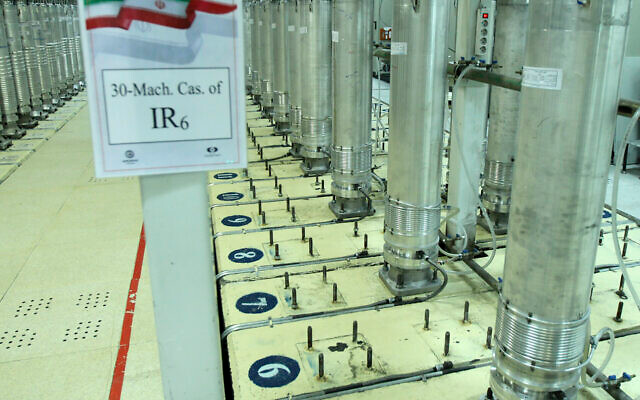
Admission of scale of damage at Natanz casts doubts on Tehran’s ability to ramp up uranium enrichment to 60%, as threatened; Israeli report says whole plant still out of commission
A senior Iranian official confirmed Tuesday that the blast at the Natanz nuclear facility, which Tehran blames on Israel, destroyed or damaged thousands of centrifuges used to enrich uranium.
Alireza Zakani, the hard-line head of the Iranian parliament’s research center, referred to “several thousand centrifuges damaged and destroyed” in a state TV interview. However, no other official has offered that figure and no images of the aftermath have been released.
His comments came as Iran said it was stepping up uranium enrichment to an unprecedented 60% — bringing Iran closer to the 90% purity threshold for military use, and shortening its potential “breakout time” to the bomb — and installing new centrifuges in response to the Sunday attack.
The remarks appear to confirm Israeli reports indicating the damage was widespread and Iran will have significant difficulty restoring its enrichment to previous levels in the coming months.
An Israeli TV report on Tuesday night said that Iran will only be able to enrich very small quantities of uranium to 60% since Natanz is still out of commission following the Sunday attack.
Channel 13 analyst Alon Ben David said that despite Iranian officials’ vow to start preparing Wednesday to begin the higher enrichment process, they cannot do it at Natanz, since the 6,000 centrifuges there remain “out of action.”
There are 1,000 centrifuges at Iran’s Fordo nuclear facility that can enrich to 60% in very small quantities, the Israeli analyst said, describing the Iranian threat of higher enrichment, therefore, as unlikely to be significant.
The weekend attack at Natanz was initially described only as a blackout in the electrical grid feeding above-ground workshops and underground enrichment halls — but later Iranian officials began calling it an attack.
On Monday, an Iranian official acknowledged that the blast took out the plant’s main electrical power system and its backup. “From a technical standpoint, the enemy’s plan was rather beautiful,” Fereydoon Abbasi Davani, the head of the Iranian parliament’s energy committee, told Iranian state television on Monday.
“They thought about this and used their experts and planned the explosion so both the central power and the emergency power cable would be damaged.”
The comments from Davani, the former head of Iran’s atomic energy organization, came as reports in Israel and the US provided new details of the early Sunday bombing and its consequences, with assessments that the blast would set back the Iranians by 6-9 months.
The New York Times reported that the blast was caused by a bomb that was smuggled into the plant and then detonated remotely. The report cited an unnamed intelligence official, without specifying whether they were American or Israeli. This official also specified that the blast took out Natanz’s primary electrical system as well as its backup.
The report said that Iran’s Atomic Energy Organization spokesman, Behrouz Kamalvandi, said the explosion inside the bunker had created a hole so big that he fell into it when trying to examine the damage, injuring his head, back, leg and arm.
Nevertheless, other Iranian officials tried to play down the damage in the underground facility.
The head of Iran’s Atomic Energy Organization, Ali Akbar Salehi, claimed earlier Monday that emergency power had already been restored at the plant and enrichment was continuing.
“A large portion of the enemy’s sabotage can be restored, and this train cannot be stopped,” he told Iranian media, according to the Times.
Iran’s Foreign Ministry said it damaged some of Iran’s first-generation IR-1 centrifuges, the workhorse of its nuclear program.
Enrichment to 60% marks a significant escalation and is a short technical step away from weapons-grade uranium. Iran had been enriching up to 20%, and even that was a short step from weapons-grade levels of 90%.
Iran’s semi-official Fars news agency said its atomic energy agency will initiate preparatory steps to ramp up enrichment on Tuesday night. The report said the damaged IR-1 centrifuges will be replaced with new machines that have a higher capacity.
The International Atomic Energy Agency confirmed in a statement that Iran warned it will start enriching uranium up to 60% purity.
In a report to member states, the IAEA’s director-general, Rafael Mariano Grossi, “said Iran had informed the Agency that the country intends to start producing UF6 enriched up to 60 percent,” the statement said.
Israel has hinted at being involved, but not officially confirmed any role in the attack. However, Prime Minister Benjamin Netanyahu has repeatedly vowed never to allow Tehran to obtain a nuclear weapon and Israel has twice preemptively bombed Mideast nations to stop their atomic programs.
 Eurasia Press & News
Eurasia Press & News

